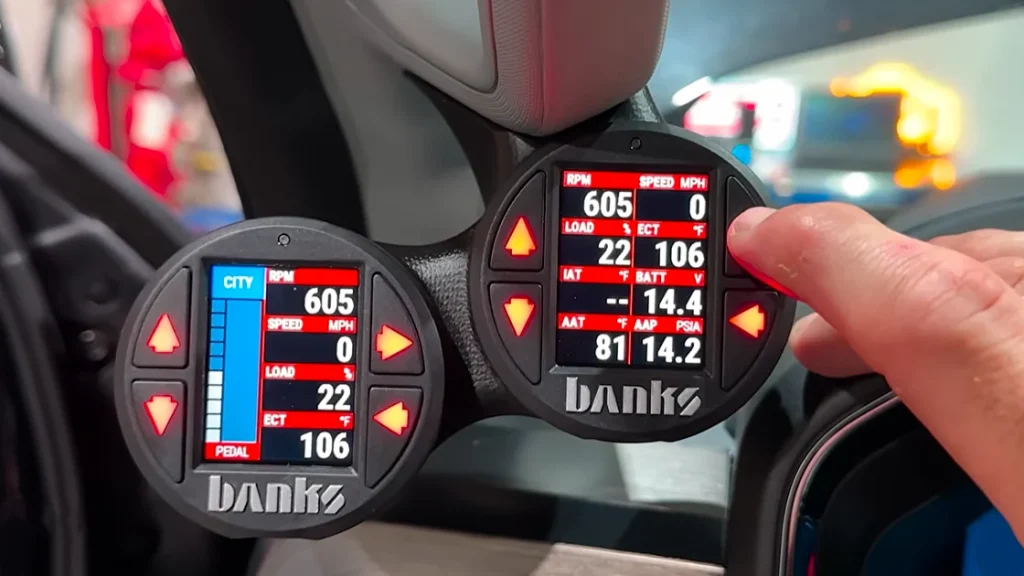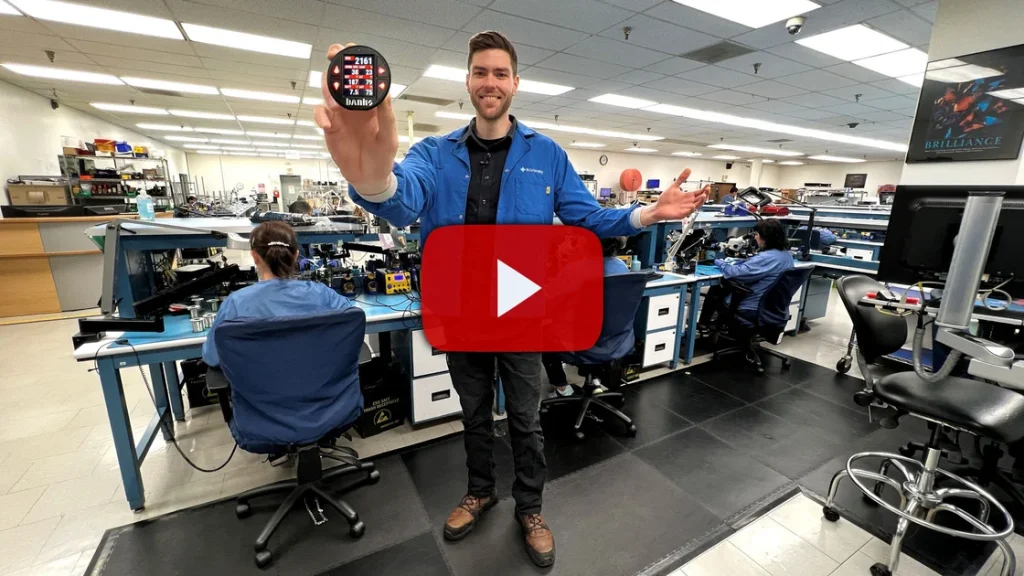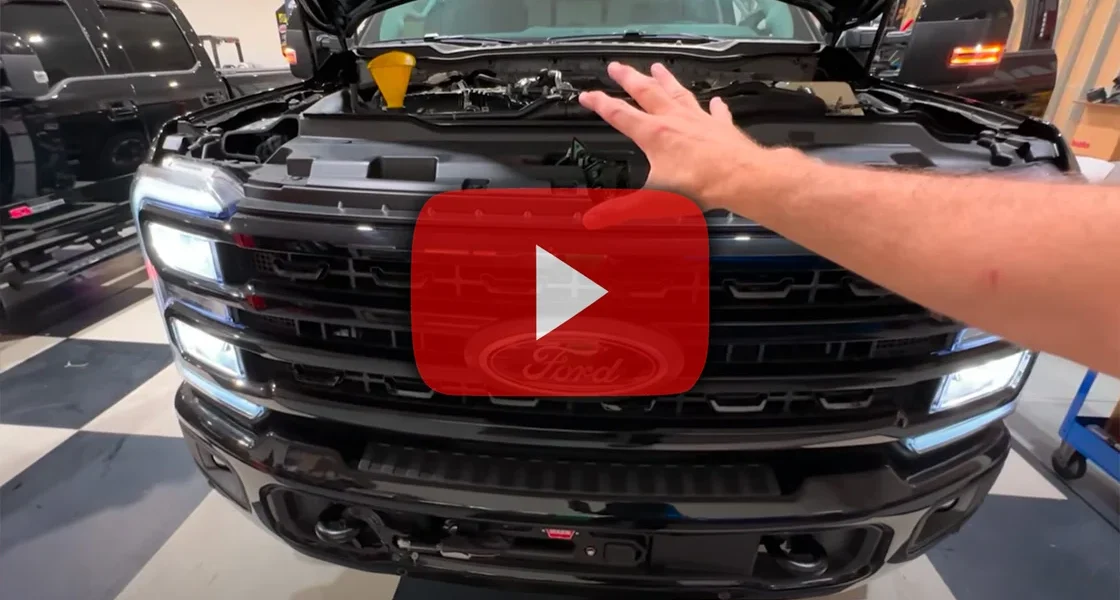Mission Control with iDash Pro for Ford Super Duty

Ford Master Tech and Power Stroke Tech Talk host ARod recently gave a 2024 Ford Super Duty the ultimate performance monitoring upgrade with the iDash Pro setup. The truck—fresh off the lot with just 90 miles—came in for a dual Stealth Pod mount, a Banks Ram-Air Intake, and two iDash Pros for maximum visibility.
“This looks factory,” says Aron, a Ford master mechanic and host of Power Stroke Tech Talk of the dual Stealth Pod mount in his customer’s ’24 Ford Super Duty With just 90 miles on the odometer, the F-250 was sent to ARod to install a Banks Ram-Air Intake and two iDash Pros. “Banks offers a bunch of different options for how much information it shows,” he says while demonstrating on the iDash Pro. “What do you want? Do want two pieces of information? Do you want five? I have eight! I don’t know if that looks too busy for you guys, but I like to see as much information as I can.”
Full Video Transcript
00:01 Welcome back everybody. Another Ford with the winch and gosh the bean bags at the dealer. They even use the trim. Hallelujah. All the way from Oklahoma where the wind goes down riding across the plains. Yeah, I don’t sing, but you know what I do well is this. I got the
00:20 triple threat Banks pusher DCR and the old fleece back here. But what this guy wanted to do as well was add a bunch of other Banks stuff inside the truck. We did do some PPE stuff under the truck if you guys can see. Oh yeah, double pans. But everybody’s been asking me, “What do
00:43 you do? How do you set up the i-Dashes?” That, my friends, we are doing right now. Let’s go. What is going on everybody, welcome back to the channel. We have a ’24—two ’24s. One yesterday and one today. This particular unit was transported to me and it has right at 90 miles on it. I really love that
01:42 cluster. Ain’t that sweet? Freaking sweet. It is hotter than the blazes of hell today. We’re going to start this thing up. I have the AC seats on. Uh, let me make sure we’re on low, low, low. And let’s get some ventilation coming my way. Right there. Now, I’ve made a video
02:05 showing how to install the single and the dual, and now Banks has come out with the iDash Pros. Now, these are a little better screen quality and you can actually change all this stuff with your phone. It hooks via Bluetooth now. So, kind of cool. Uh, a little
02:29 different than what we were accustomed to. But nonetheless, it is definitely something you should add on. I mean, look at the install. This thing looks factory—like it should be here from day one. I mean, technically, it is day one, right? I mean, hello. Let’s
02:47 familiarize ourselves with the Banks gauges. We have enter and we have back. Okay. And then obviously these up and down arrows are going to, you know, go through the appropriate menus. Now, Banks has a whole bunch of different views. If you want less clutteredness,
03:08 you can go to gauge layout, hit enter, and then what do you want to look at? Do you want two pieces of information? Do you want five? I have eight. I don’t know if that looks too busy to you guys, but this is kind of what I like to see—as much information as I can. Now, do we want an
03:30 RPM gauge? Because we have an RPM gauge here. I know we can’t get specific numbers, but I like to know what RPM she’s really sitting at. Especially if I have the BD high idle kit, I’ll really dial this into, you know, 1250 or wherever I’m keeping it sat at, I guess. All right,
03:50 so let’s get rid of—let’s go to the gauge selection. This is all eight blocks that we just had. Now, do we need speed? No, we have speed on our instrument cluster. Let’s go to category. I want to look at pressures. Pressures are a big one for me. Boost pressure—yes,
04:13 absolutely. I don’t care what this tells me. It doesn’t give me an actual number. I want to see in numerals what boost is going to be. Let’s go back and see what it’s reading. Right now, we’re sitting at 0.5 PSI and 600 RPM. So, let’s see what the RPM raising level is and how much
04:40 boost equates with that. You see how high RPM went and how much boost that’s making. Check that out. I think that’s important. Load—if you’re diagnosing a truck, then I’m going to say let’s do load. But for all you guys out there who are driving and want to monitor
05:09 stuff, I don’t think load is something you’re going to really care about. But let’s go back to pressure. Boost pressure—absolutely. I don’t care about TPMS because we got that on the truck. FRP commanded fuel rail pressure—I want that just because we got the DCR
05:26 on here. I want to see that fuel rail pressure. Look at that. Crisp. And if it’s crisp, you know we going jam. All right, let’s go to—if you guys are probably wondering why the IAT 1’s not working, this was just configured with how it came and I think we’re on the wrong IAT sensor.
05:48 Go—I’m hitting it wrong. Enter. Let’s go down to ECT. Do we want to know ECT? We have it on the truck. I don’t think—let’s see what else. MAP. MAP. MAP. Okay, I could do MAP. Let’s get rid of that and let’s go to pressure again. Exhaust back pressure should be rising just like
06:21 MAP should. Let’s go back and look at it. So, we have MAP with the truck off. Oops. With the truck off, manifold absolute pressure and EBP should all be about 14.7–14.1 PSI. Let’s see what it goes to. Okay, key off. I’m going to turn the key on. All right, look at our pressure
06:49 sensors. That’s right where they should be. That is zero. See how much boost we have. We have nothing in the intake—oops—we have nothing in the intake because we have no boost. MAP is reading what’s pushing on us right now. 14.2 PSI is pressing down on this right now. Let
07:06 me start it back up. Okay, here comes our MAP. And you saw our EBP jump up. So, let’s look at when we give it some boost—how much MAP is changing. MAP has to go up. EBP has to go up. This is how we all deliver our boost and our fuel—by learning how much crap can
07:31 I shove into the exhaust? How much crap can I shove into the manifold? It’s looking at those sensors to know how much boost it wants to give out. So, let’s go down to battery. I know a lot of you guys like the battery voltage ‘cause we don’t really have a voltmeter on the full focus on the
07:50 instrument cluster. So, I think for sake of argument, I’m going to leave a number six for this gentleman. Let’s go to number seven. Seven. Let’s go to group. Let’s go to exhaust—no, let’s go to category. And let’s go to temperature. Perfect. All right, let’s go down to—I want exhaust
08:20 temperature bank one sensor one. Okay. And let’s do field eight. Let’s do the same thing—temperature and let’s do the rear EGT. Okay. EGT sensor 14. And let’s go over here. Let’s go over and change this guy. So we have RPM, boost, MAP, FRP, EBP, battery voltage, EGT1, EGT14.
09:04 This is right at the DPF—first one in the DPF. Look at that. All right. So now let’s go—let’s get rid of RPM up here because we don’t need RPM. Gauge layout. Gauge selection. I’m going to get rid of RPM. Let’s go down to group. Let’s go to transmission.
09:45 Yeah, torque converter status—I like to know when my torque converter is locked. Speed—we don’t need speed. Let’s go down—what else would I pick? Trans diagnostics. I thought I saw emission up here… ninja performance? Transmission—let’s go out of here. Category—
10:12 emission. There we go. I want you guys to be able to pull up that right there—DPF regen status. It’s actually going to give us a trigger and it will say when we are actually in regen. Speed and velocity—eh. Transmission—we already have transmission tab on the vehicle. We have two more to pick,
10:38 right? Let’s get rid of load. Let’s go to engine performance. Engine performance—mass air flow, turbo vane. I don’t know if you guys would really care, but I got that pulled up on mine so I know where VGT is. Fuel tank—we don’t need—whoa, we don’t need that.
11:04 Air fuel ratio, cylinder head—no. Let’s do this… no. Air density—I don’t think that’s really anything. Oh, vehicle performance—let’s check that out. Vehicle performance—calibrated engine load, oil life remaining, idle commanded torque percent, commanded
11:38 torque, actual engine reference torque, torque EC. Check those out. Let’s see how much horsepower we’re making and torque. Let’s see if we got torque right there. Oh, I went down to the wrong one. We got to change that one. I’m an idiot. Vehicle performance—go down to horsepower. Select. Okay,
12:08 look at all of this data we have right here. Let me go ahead and—I don’t know why that’s not on or displaying. Let me see if it’ll come back on. Let this reboot. Shut it off. See if it’ll come back on. [Music] There we go. So, we just had to power on. So right now, sitting at no boost,
12:41 we have 600 RPM. The ECU, the powertrain control module, is equating that we’re making 10 horsepower right now. Obviously, we have not gone and driven this and there’s no load being placed on this vehicle. We’re just sitting here in the stall, but I mean that’s kind of
13:04 neat—especially this. I like to know when the torque converter is locked and that as well. We want to know when it’s in regen so we don’t shut this thing off. If you guys are going to opt for the Pedal Monster, which is on this side, you can see the red is Banks, the
13:22 white is factory input. Oh, I’m hitting the pedal—can’t do it with any pedal, but you can do this on the fly. Right now, stock. You can feel that right now. Let’s go up to—let’s go to sport one. Oh, wow. Look at all that red it gets you. Look at that. Let’s go—
13:46 let’s go all the way to track. Track all the way up. Damn, that is such a big difference. Wow. Let’s go back down. I have mine on city—I think city eight or city one, two, three, four, five, six. City six. All right. So, if you’re hooking up the Pedal Monster, you are going to have to
14:13 go down to the very bottom one—well, not very bottom one, I should say—you’re going to go down to the Banks modules and you’re going to select Pedal Monster. Now, you can adjust your Pedal Monster right here, but when you guys get it, you’re going to have to do the calibration, and it’s
14:36 going to say incomplete. So, you’re going to hit this, and this is going to tell us what it wants to do. Do you want to do the pedal calibration? Yes. Press gas pedal completely—yes. Release gas pedal. Depress gas pedal. And release the gas pedal. Calibration complete. So now you’re going to see it
14:60 say complete. Go ahead and we’ll start it back up. What I also want you guys to know too—when you first start it up, vehicle selection—make sure you pick which one you have. All I did was pick the Ford. We can go through and change the color.
15:24 Let’s see what red and white looks like. Oh, wow. So, you can see the contrast difference. You can go back and pick all of this stuff. Let’s see what blue and white looks like. Oh, wow. Damn. I don’t like that white though. I like how the blue is—what’s this? Black Ops. Oh. Oh.
15:59 I don’t know if you guys can pick that up, but these are almost kind of teal. I don’t know. I kind of like that. Let me see what—screen and button—auto dimming on. So actually these are little sensors right here that are going to adjust the brightness when we’re driving.
16:23 Um, okay. Speed correction, wake up sensitivity, Black Ops. E—what about the amber? Oh. Oh, yeah. I like that. You guys got to check that out. Little easier on the eyes. Oh yeah, Gale, you guys got it going on. I like it, dude. Freaking awesome. Like I said, you guys can change this stuff
16:57 through your phone, connecting it via Bluetooth. Oh, here we go. Check this out—matching. Oh, yeah, dude. I freaking love it. You can’t really get this on camera—oh, there, maybe you can now. See how the buttons look yellow? I really like that. That looks really
17:21 nice. Damn. I’m going to have to get some iDash Pros. Man, I really like that. I want you guys to sophisticatedly install and program these just how I showed you. I think the information that I have pulled up is probably the most important, most pertinent information
17:41 that you probably could utilize. It’s not information that you can’t decipher—boost, how much is that? Temperature, how much is that? Especially when you’re towing or if you’re fooling around and want to know exactly what’s reading. I forgot one thing—let me show you this, too. If for
18:00 whatever reason your check engine light comes on—oh gosh, I forgot to tell you a very important thing. Let’s zoom back in so you guys can see. Go to diagnostics. Hit enter. Pedal Monster info—nope. Banks modules diagnostics—vehicle. There we go. Vehicle—check DTCs. Clear DTCs.
18:33 Let’s do a little DTC check. We did have a bunch of stuff disconnected. I don’t have any lights on, but let’s see. Oh, look at that—no codes found. So, if you had any codes or a check engine light came on and you were on the road, you don’t need a scan tool. Banks
18:50 has got you covered with the iDash—something that is very good, something that works very well. You definitely pay for what you get for, especially when buying parts that we put on these trucks. I’m here to make your 6.7 great again. It was great—I’m making them even better with
19:11 these awesome parts. Let me know if you guys want to get in for an appointment here in the Detroit area or if you want to visit our shop in the Florida region. I’m doing one truck a day with maintenance in between. So, if you guys can be patient, I will take care of
19:30 every single one of you. I’m just a one-man show doing the best work that I can for you guys. I appreciate you guys for watching. Remember to like, comment, sub, share, and we’re going to have this truck idle up. Idling. Idle. Idle. Heat. Heat. [Music] [Music] [Music] Oh no.
The iDash Pro also integrates seamlessly with other Banks products, like the PedalMonster where you can tweak throttle sensitivity on the fly, going through modes like CITY, SPORT, and TRACK. ARod demonstrates the pedal sensitivity by selecting TRACK and romping on the pedal a bit, showing visually on the iDash just how much more sensitive the throttle is, though his expression says it all. “Look at all that it gets you. That is such a big difference!”

“What I’ve pulled up is probably the most important, most pertinent information that you could utilize, like how much boost am I making? Where are my temperatures at? Especially when you’re towing, or if you’re fooling around. You want to know exactly what’s happening with your engine.” The iDash Pro also doubles as a diagnostic tool. “If you’re on the road and have any codes, you don’t need a scan tool. Banks has got you covered. You definitely get what you pay for. For anyone serious about performance monitoring, it’s freaking awesome!”
See more Ford Power Stroke upgrades from Banks


